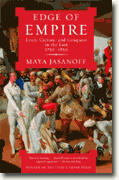Edge of Empire
Maya Jasanoff
book reviews:
· general fiction
· chick lit/romance
· sci-fi/fantasy
· graphic novels
· nonfiction
· audio books
· author interviews
· children's books @
curledupkids.com
· DVD reviews @
curledupdvd.com
newsletter
win books
buy online
links
home
for authors
& publishers
for reviewers

 |
Edge of Empire: Lives, Culture, and Conquest in the East, 1750-1850 Maya Jasanoff Vintage Paperback 416 pages September 2006 |
|
The sociopolitical paradigm of the Western hemisphere shifted during the 18th century. England and France were constantly at war with one another, and their rivalry would soon spread to the American colonies. England was overwhelmed by independence-seeking colonists in America, while France would soon experience a revolution of its own. Reflecting on this period, we find ourselves so focused on the occurrences in the West that we seem to overlook the rising British and French influence in the Eastern hemisphere.
For England and France, collecting was a contest driven by national prestige. Objects became the fortune of battles and plunder. The Kingdom of Mysore, a French ally, fell to the East India Company in 1799. British soldiers looted the town of Serigapatam and stripped the corpse of the Mysore ruler, Tipu Sultan. Soldiers sold their riches inexpensively. With Mysore’s defeat, the East India Company became a collector. England was “obsessed with racial purity and social hierarchy, convinced of the superiority of whites to non-whites, Christians to heathens, and Britons to everyone else.” Back in Europe, the demand for Eastern goods grew astonishingly. Eyes soon turned to Egypt, where the ruins of pharaohs’ tombs were raided. Relics were taken to either England or France for personal collections and exhibitions. The want to expand would continue, and new collectors would soon join the quest. Europeans with little to no relevance in the English and French social structures were able to recreate themselves abroad. Their collections enabled them take pleasure in a new way of life and to attain economic wealth. Robert Clive, Claude Martin, and Antoine Polier were among this new-fangled group of people. Employed by the British East India Company, they indulged in the Indian lifestyle, collected items of the Orient, and were intimate cohorts of the nawab of Awadh, Asuf ud-Daula. Together they would witness and appreciate the grandeur of Lucknow. Those who journeyed back to Europe found themselves in a different world. Having made their wealth from fortunes acquired in India, they were branded as nawaabs. Jasonoff’s first book, Edge of Empire is very insightful and presents several anomalous facts. While she does not dismiss the misfortunes of imperialism, she does successfully present it in a dimension. Using a vast number of secondary sources, Jasonoff builds Edge of Empire into an informative piece of work. Indeed, the book concludes as an exciting interpretation on the history of British and French imperialism. Originally published on Curled Up With A Good Book at www.curledup.com. © Bridget D. Harrell, 2006 |
|
|
|
 Click here to learn more about this month's sponsor! |
|
| fiction · sf/f · comic books · nonfiction · audio newsletter · free book contest · buy books online review index · links · · authors & publishers reviewers |
|
| site by ELBO Computing Resources, Inc. | |
 In Edge of Empire: Lives, Culture, and Conquest in the East 1750-1850, Maya Jasonoff “deliberately takes an unconditional approach investigating imperial expansion.” Jasonoff explains that imperialism from India to Egypt was more than the acquisition of land. It was the collection of culture and objects. Both country and man would find themselves collectors and Orientalists.
In Edge of Empire: Lives, Culture, and Conquest in the East 1750-1850, Maya Jasonoff “deliberately takes an unconditional approach investigating imperial expansion.” Jasonoff explains that imperialism from India to Egypt was more than the acquisition of land. It was the collection of culture and objects. Both country and man would find themselves collectors and Orientalists.